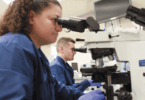It’s believed that every cancer comes down to a gene mutation of some kind, although it’s estimated that roughly 90 percent of all cancer diagnoses are deemed sporadic, which means the gene mutation occurs randomly and has little or nothing to do with family history. That leaves about 10 percent of cancers tied to inherited gene mutations that increase cancer risk.
Since the mid-1990s, the BRCA1 andBRCA2 (BReast CAncer 1 and 2) genes have received enormous attention due to the fact that women testing positive for mutations in these two genes face a much higher risk of developing breast and ovarian cancer when compared with the general population. In addition, mutations in these genes can be passed down to children from either parent.
Determining whether to test begins with a thorough family medical history, says Luba Djurdjinovic, MS, Executive Director of Ferre Institute, Inc., a non-profit organization that provides services in genetics and reproductive health to breast centers, cancer centers, and heart centers in upstate NY, including the UHS Breast Center. Within the 90 percent of women without inherited high risk gene mutations, about 30 percent of women fall into the familial category, meaning that a patient’s family history includes one or two relatives between 50 and 70 who were diagnosed with breast cancer. “Breast cancer risk increases as we age, so this kind of history does not indicate high risk,” Ms. Djurdjinovic explains. “But it does tell a physician that this patient needs annual screenings and suspicious findings should be closely followed.”
The remaining 60 percent of women in this category need an acquired risk factor to trigger breast cancer, which is a “hotly debated topic,” Ms. Djurdjinovic adds. “Is that risk factor diet, exercise, hormones, alcohol, smoking? It could be any one of those and we’re not sure which.” What the medical community does know, however, is that these women are considered at low risk for breast and ovarian cancer and should follow their doctor’s screening recommendations.
So the initial mission of genetic counseling, Ms. Djurdjinovic stresses, is to give a woman answers about potential inherited risks, which may or may not involve genetic testing. “Everyone needs to sit down with their family and sort this out.”
If genetic testing is called for, there are several possible benefits.
- Cancer screenings can be tailored to test results, including frequent screenings with advanced technology. This may include mammography as well as MRI. Time is of the essence when dealing with any cancer, and early detection improves outcome.
- Test results help guide patients in choosing approaches for cancer-risk reduction, such as surgery.
- Family members, including daughters and siblings, may benefit from knowing about an inherited risk factor for breast or ovarian cancer.
Deciding whether to test for genetic information and then discussing results is an “important conversation among a women’s entire medical team, including her doctor, nurse practitioners, and genetic counselor,” Ms. Djurdjinovic says. “It’s very important that everyone clearly understands how all this information can be used, so the test results benefit the family for generations to come.”







